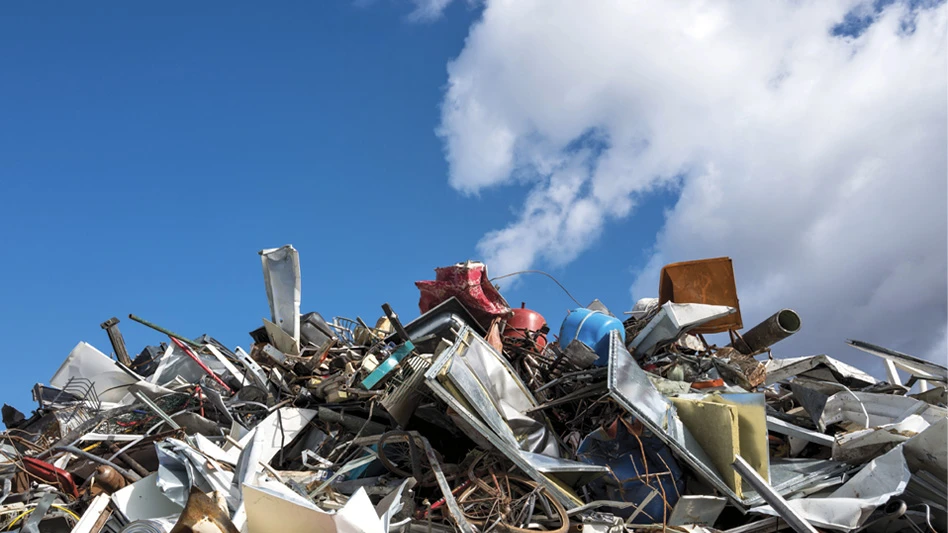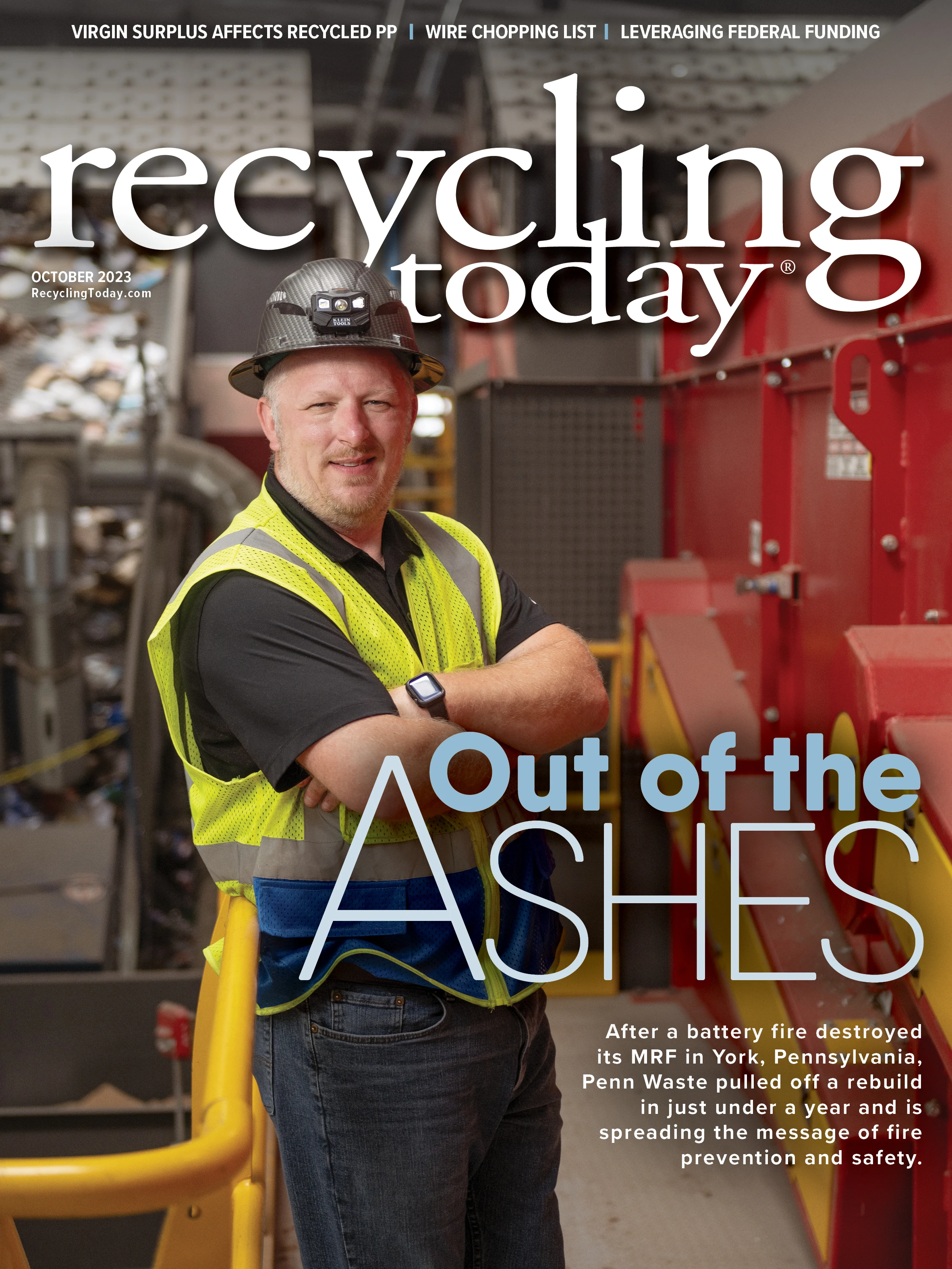

Electric material handlers might be viewed as novelties by some scrap processors compared with traditional diesel machines, however, equipment manufacturers say electric options are proving to provide the same level of reliability.
“Electric material handlers have had a very long tradition at [Terex Fuchs], with our first electrically powered equipment being delivered to customers as early as the 1980s,” says Florian Bender, head of product management and marketing at Terex Corp., headquartered in Norwalk, Connecticut.
Bender recently visited a scrap yard in Germany that uses an electrically powered machine that has accumulated 100,000 operating hours.
“The performance of our electrically powered machines is in no way inferior to that of our diesel-powered variants,” Bender says. “On the contrary, thanks to the extremely load-stable electric motors combined with the high torques, electric machines offer strong performance in the field.”
Cimco Resources Inc., based in Loves Park, Illinois, gained firsthand experience with that “strong performance” when it began to operate an electric scrap handler last year. The company added an electric-drive 870 Hybrid material handler from Sennebogen, a German company with a U.S. subsidiary, Sennebogen LLC, based in Stanley, North Carolina, to its scrap yard in Sterling, Illinois. That recycling facility is one of six the company operates in Illinois.
For many years, a diesel-powered crane fed materials to the auto shredder at the Sterling yard. The facility receives up to 800 tons of material per day, with much of it destined for the site’s Metso auto shredder.
“We run multiple products through our shredder, so we have multiple piles of materials around the infeed area,” says Ron Brenny, operations manager at Cimco Resources.
Cimco mounted the 220,000-pound 870 Hybrid material handler on a 9-foot pedestal. The machine features a 90-foot boom that can reach multiple piles of sorted material without moving, and the semistationary material handler features tracks so it can be moved through the yard as needed.
After adding the 870 Hybrid last year, Brenny says he noticed an improvement in efficiency when feeding the shredder, noting it’s a quick machine with fast cycle times despite its large size. “It’s unbelievably quick, probably as fast as a smaller [material handler],” he says.
Addressing range

While reduced mobility can be a concern for scrap processors trying electric scrap handlers, many manufacturers say they offer solutions.
Christopher Keyes, product manager at Newport News, Virginia-based Liebherr USA Co., says many manufacturers offer battery packs or mobility packs to ensure these scrap handlers continue to run as they move around a yard.
Keyes visited a scrap yard in Munich that was operating a Liebherr electric material handler equipped with a battery pack and says that machine ultimately helped the yard increase its cycle times loading its shredder.
Colleen Miller, sales and national accounts manager at Sennebogen LLC, says while diesel-powered material handlers sometimes struggle to start in extreme temperatures, electric-powered material handlers are able to start regardless of the working conditions.
“Whether working in northern British Columbia in negative degrees or in Arizona, electric material handlers always run,” Miller says. “That’s an advantage for customers working in extreme conditions. You won’t have issues with ambient temperatures.”
Increasing adoption
According to Brenny, Cimco is one of the first scrap processors to add Sennebogen’s 870 Hybrid into its operations.
Material handler manufacturers say adoption of these machines has been somewhat slow in the U.S., and Keyes says he suspects the fear of change has affected that rate.
“An owner of a company that has been very successful for many years working with the same type of machines is naturally reluctant to change in a new system,” he says.
However, many makers of material handlers say they think more electric models will be adopted in the U.S. in the coming years.
“Europe is generally very tech-savvy,” Bender says. “The development of electric drives is being actively driven primarily by our European customers. Scandinavia, for example, is playing a pioneering role in the field of zero emissions. Government subsidy programs are increasing demand for more environmentally friendly drives and at the same time accelerating technical developments.”
Miller says high diesel costs have helped push scrap processors in Europe to make the switch to electric options.
“The cost of diesel is very different in the U.S. than in Europe,” she says. “Diesel costs four times more in Europe. If you’re paying four times [more] for diesel, you’re going to look at other options. … So, more European companies are adopting electric models.”
Bender says he sees steadily growing demand for electric-powered material handlers in the U.S. “While this has not yet reached the same extent as in Europe, we are certain that we will see significantly more electrically powered handling equipment in the U.S. in the future.”
Doing the math

Brenny adds that the overall purchase cost might be another factor deterring some processors from adding electric material handlers to their fleets.
“The only thing I can see why someone would have hesitation is the cost,” he says. “You’re looking at paying almost twice as much [for an electric material handler]. You have to justify why you’re paying that.”
Miller adds that some of Sennebogen’s customers have taken advantage of grant funding to integrate electric equipment in their facilities. She says one of the company’s customers in the port industry received a grant from the Environmental Protection Agency that covered 65 percent of the cost of an electric material handler and fully covered the cost of bringing power to the site.
“To think that 65 percent of that project is paid for by the government is an unbelievable victory,” she says.
Despite the higher initial price tag on the electric model Cimco purchased, Brenny says the 870 Hybrid has more than paid for itself in the past year.
He says the company decided to choose an electric material handler because it provided dependability, less downtime and significantly less maintenance than diesel options.
Although diesel machines might offer more mobility, Brenny says they require a bigger investment in maintenance, adding that electric options are almost maintenance-free compared with diesel.
“With the cost savings in maintenance, we feel the electric model basically paid for itself in that way,” he says.

Explore the October 2023 Issue
Check out more from this issue and find your next story to read.
Latest from Recycling Today
- Phoenix Technologies closes Ohio rPET facility
- EPA selects 2 governments in Pennsylvania to receive recycling, waste grants
- NWRA Florida Chapter announces 2025 Legislative Champion Awards
- Goldman Sachs Research: Copper prices to decline in 2026
- Tomra opens London RVM showroom
- Ball Corp. makes European investment
- Harbor Logistics adds business development executive
- Emerald Packaging replaces more than 1M pounds of virgin plastic





